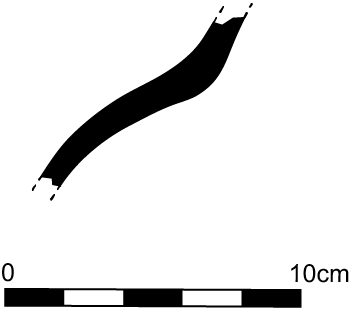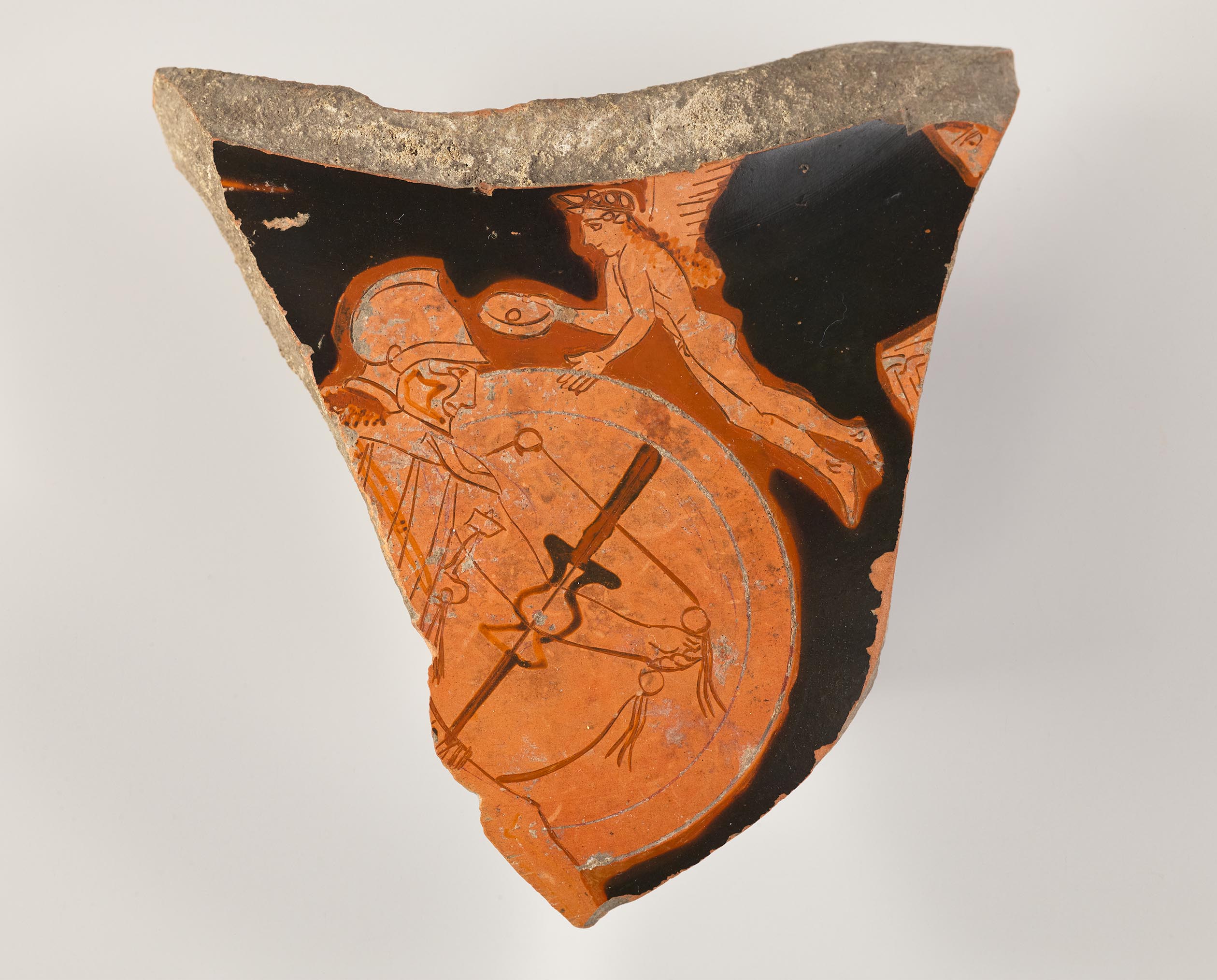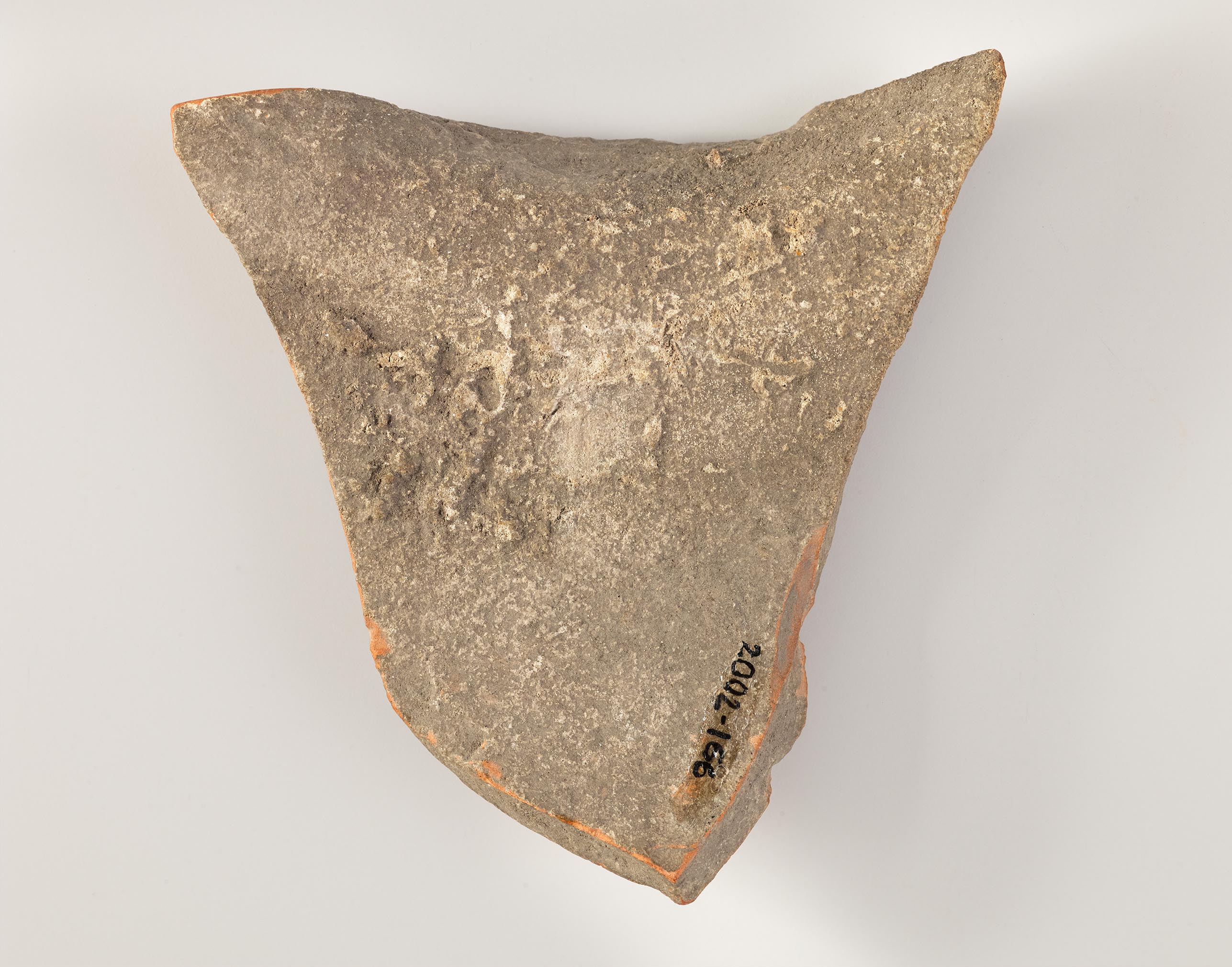Provenance
2002, gift, Emily Townsend Vermeule and Cornelius C. Vermeule III (Cambridge, MA) to Princeton University.
Shape and Ornament
Single fragment from the shoulder. Continuous curve between neck and shoulder. Interior reserved. No ornament preserved.

Subject
Reclamation of Helen. At the left, the beardless Menelaos rushes to the right, wearing a chitoniskos and a crestless Thracian helmet while carrying a shield on his left arm. His long hair protrudes from beneath the back of his helmet. His sword remains in its scabbard. Above the shield hovers Eros, who flies to the left, grasping the edge of the shield in his left hand and holding a phiale in his right. Eros wears a garland with reserved leaves in his long, curly hair. Helen is at the right, possibly fleeing from her oncoming husband, although her body and legs are not preserved. She turns her head to meet Menelaos’s gaze, and plucks up her chiton.
Attribution and Date
Unattributed. Circa 460–440 BCE.
Dimensions and Condition
8.9 × 9.3 cm; thickness: at lower shoulder 0.7 cm; at transition from shoulder to neck 1.6 cm. Broken on all sides. Interior heavily incrusted. Details on both figures, as well as the eighth-inch bands surrounding them, have misfired red, although the background of black gloss fired a glossy black. This contrast suggests that different slips were used for the various components of the decoration.
Technical Features
Relief contours. Accessory color. Dilute gloss: cheekpiece of Menelaos’s helmet; straps of his baldric; Eros’s long locks. Borders of Menelaos’s shield incised with compass.
Bibliography
L. B. Ghali-Kahil, in Abbreviation: LIMCLexicon Iconographicum Mythologiae Classicae. 1981–2009 4 (1988), 544, pl. 342, no. 279 bis, s.v. “Hélène”; M. Stansbury-O’Donnell, “Menelaos and Helen in Attic Vase-Painting,” in Abbreviation: Athenian Potters and PaintersAthenian Potters and Painters: The Conference Proceedings. 3 vols. Vol. 1, edited by J. H. Oakley, W. D. E. Coulson, and O. Palagia. Oxbow Monograph 67. Vol. 2, edited by J. H. Oakley and O. Palagia. Vol. 3, edited by J. H. Oakley. Oxford, 1997 (vol. 1), 2009 (vol. 2), 2014 (vol. 3), vol. 3, 248, fig. 7; Abbreviation: BAPDBeazley Archive Pottery Database. http://www.beazley.ox.ac.uk 9030388.
Comparanda
Although unattributed, the painter of this vase was a careful draftsman. Note the extensive use of relief contours and relief lines, even for minute details on Eros, including the articulation of his ankles, garland, and wings. D. von Bothmer (Abbreviation: LIMCLexicon Iconographicum Mythologiae Classicae. 1981–2009 4 [1988], 544), is said to have suggested that the artist was one of the Earlier Mannerists, who often decorated their hydriai with framed pictures on the shoulder: see Abbreviation: Mannack, Late ManneristsT. Mannack. The Late Mannerists in Athenian Vase-Painting. Oxford, 2001, 57–60. The Reclamation of Helen, however, is quite rare within that workshop, and when depicted is compositionally far removed: cf., e.g., Tübingen 67.5806 (Abbreviation: ARV2J. D. Beazley. Attic Red-Figure Vase-Painters. 2nd ed. Oxford, 1963 585.27, 1660; Abbreviation: BAPDBeazley Archive Pottery Database. http://www.beazley.ox.ac.uk 206757). The details of drawing also do not resemble the Earlier Mannerists. Kalpides with figural scenes on the shoulder are quite common within the Group of Polygnotos, including one by the master himself, which shows the Reclamation of Helen: Athens 14983 (Abbreviation: ARV2J. D. Beazley. Attic Red-Figure Vase-Painters. 2nd ed. Oxford, 1963 1032.60; Abbreviation: Matheson, PolygnotosS. B. Matheson. Polygnotos and Vase Painting in Classical Athens. Madison, Wisc., 1995, 360, no. P 65, pl. 58; Abbreviation: BAPDBeazley Archive Pottery Database. http://www.beazley.ox.ac.uk 213443). The placement of the scene on the shoulder, the execution of the eyes, with single lines for both the upper and lower lid, and the pointed nose of Menelaos all occur within the early work of the Group of Polygnotos, and on vases by other mid-fifth-century painters, such as the Danae and Villa Giulia Painters: cf., by the Villa Giulia Painter, Vatican 16506 (Abbreviation: ARV2J. D. Beazley. Attic Red-Figure Vase-Painters. 2nd ed. Oxford, 1963 623.70; Abbreviation: BAPDBeazley Archive Pottery Database. http://www.beazley.ox.ac.uk 207224), especially the eyes of the figures, and the hair and garland of Apollo, which recall those of the flying Eros on Princeton’s fragment.
The shoulder of the fragment is nearly flat, suggesting that the vase dates to well into the fifth century: cf. the sloping shoulder on a Late Archaic kalpis by the Berlin Painter, New York 10.210.19 (Abbreviation: ARV2J. D. Beazley. Attic Red-Figure Vase-Painters. 2nd ed. Oxford, 1963 209.169; Abbreviation: BAPDBeazley Archive Pottery Database. http://www.beazley.ox.ac.uk 201987), with the name-vase of the Meidias Painter, London E 224 (Abbreviation: ARV2J. D. Beazley. Attic Red-Figure Vase-Painters. 2nd ed. Oxford, 1963 1313.5, 1690; Abbreviation: BAPDBeazley Archive Pottery Database. http://www.beazley.ox.ac.uk 220497). The placement of the figures on the shoulder also supports a date around the mid-fifth century. Although popular before 500, this schema falls out of favor in the first half of the fifth century with artists preferring to have the main picture cover both the shoulder and the body. As suggested by Diehl, shoulder-decorated hydriai may have been reintroduced in the workshop of Polygnotos: E. Diehl, Die Hydria: Formgeschichte und Verwendung im Kult des Altertums (Mainz, 1964), 61–62. The Group of Polygnotos frequently combined figural scenes on the shoulder with a main picture on the body, beginning around 450 BCE. Images confined to the shoulder on kalpides within the Mannerist Workshop are also quite common, most often without a main picture on the body. Given the state of preservation, it is unclear to which scheme Princeton’s fragment belongs. For a discussion of the development of decorative schemes on red-figure kalpides, see M. B. Moore, Attic Red-Figured and White-Ground Pottery, Abbreviation: AgoraAthenian Agora (Princeton 1953– ) 30 (Princeton, NJ, 1997), 38–39. For kalpides within the Group of Polygnotos, see Abbreviation: Matheson, PolygnotosS. B. Matheson. Polygnotos and Vase Painting in Classical Athens. Madison, Wisc., 1995, 184. For the shape within the Earlier and Late Mannerists, see Abbreviation: Mannack, Late ManneristsT. Mannack. The Late Mannerists in Athenian Vase-Painting. Oxford, 2001, 57–60.
For the iconography of the Reclamation of Helen, see Princeton y1986-34 a–q (Entry 12). The subject of Menelaos in pursuit of Helen gained in popularity in the second quarter of the fifth century. Although much of Menelaos’s body is missing, enough remains to suggest his complete stance. In the Reclamation, Menelaos most commonly either holds his sword in hand or drops his sword to the ground at the sight of Helen. Since his sword is still in its scabbard on Princeton’s fragment, his right hand is most likely empty and placed behind his body in a gesture denoting rapid movement, which occurs frequently in scenes of the pursuit, albeit often with the sword explicitly dropped on the ground: cf., inter alia, an amphora by the Painter of Leningrad 702, Naples M 1354 (Abbreviation: ARV2J. D. Beazley. Attic Red-Figure Vase-Painters. 2nd ed. Oxford, 1963 1194.6; Abbreviation: BAPDBeazley Archive Pottery Database. http://www.beazley.ox.ac.uk 215791). Several Classical versions of the Reclamation of Helen are compositionally similar to Princeton’s fragment, including Menelaos’s Thracian helmet, the flying Eros, and lack of an explicitly drawn or dropped sword: cf., also by the Painter of Leningrad 702, St. Petersburg 4524 (Abbreviation: ARV2J. D. Beazley. Attic Red-Figure Vase-Painters. 2nd ed. Oxford, 1963 1194.7; Abbreviation: BAPDBeazley Archive Pottery Database. http://www.beazley.ox.ac.uk 215792). On Princeton’s fragment, Menelaos is apparently beardless, for which no comparison has yet been found.
As suggested by Stansbury-O’Donnell (“Menelaos and Helen,” 248), the fact that Menelaos’s sword remains in its scabbard on Princeton’s fragment likely signifies a change of attitude from anger to lust, in a similar fashion to the more common motif of the dropped sword. Scenes in which Menelaos does not brandish his sword as he chases Helen are most common before the middle of the fifth century. Eros’s presence directly above Menelaos, which becomes increasingly common beginning in the second quarter of the fifth century, highlights the god’s role in bringing about this transformation: cf. Paris, Louvre G 424 (Abbreviation: ARV2J. D. Beazley. Attic Red-Figure Vase-Painters. 2nd ed. Oxford, 1963 1077.5, 1682; Abbreviation: BAPDBeazley Archive Pottery Database. http://www.beazley.ox.ac.uk 214486), on which both Aphrodite and Eros intervene in the pursuit while Menelaos drops his sword. Stansbury-O’Donnell also suggests that, on Princeton’s fragment, Helen performs an anakalypsis gesture, typically found in wedding scenes, and thus further emphasizing the reconciliation between husband and wife. However, Helen simply seems to be plucking her chiton as she moves to the right, rather than unveiling her face in a true anakalypsis: cf. the unveiling anakalypsis gesture of Helen on Princeton y1990-20 a–c (N. Kunisch, Makron [Mainz, 1997], pl. 45.135; Abbreviation: BAPDBeazley Archive Pottery Database. http://www.beazley.ox.ac.uk 22040).

